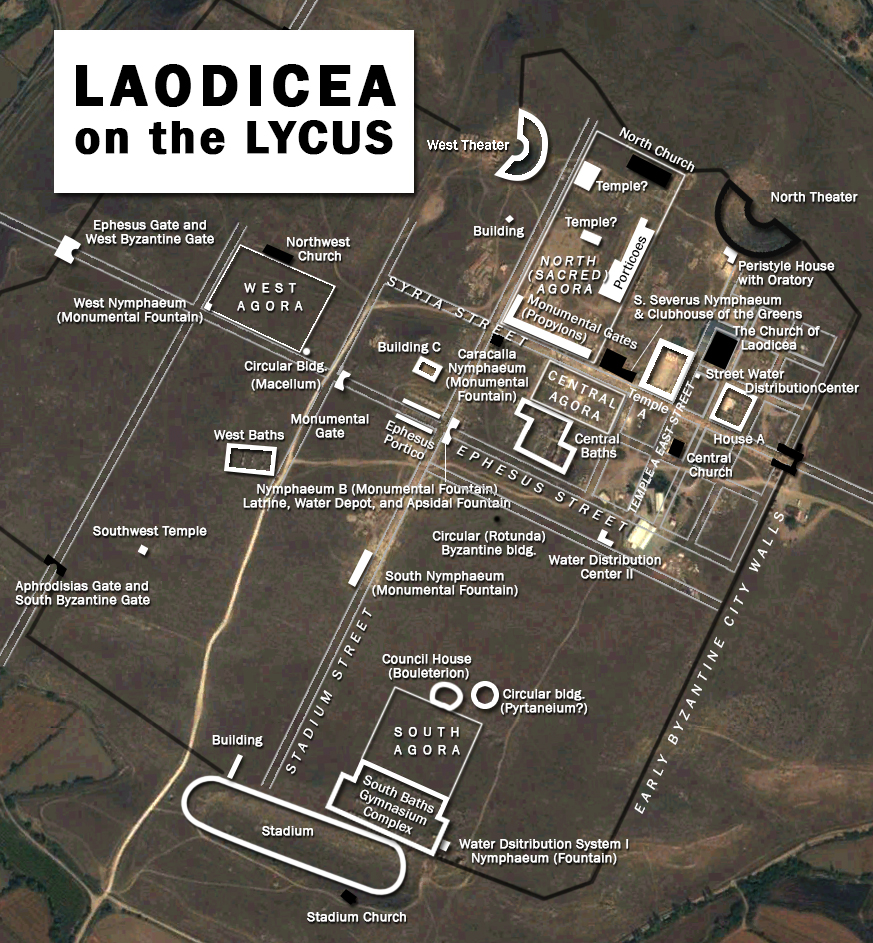
Based on official site map of the Laodikeia Excavation (“Laodikeia_Yerleşim_Plani_2015_ing-Model%20copy.jpg”), see link below. Locations and sized only approximate in some cases.
View without labels
Official excavation plan of Laodicea on the Lycus, with many detailed pages describing finds.
Zoom out to “Biblical cities of the Lycus Valley”
Zoom out farther to “Patmos & Cities of the Apocalypse
Zoom out even farther to Asia Minor
Zoom way out to “Lands of the Eastern Mediterranean”
In the middle of the third century B.C., the Seleucid Antiochus II founded Laodicea to command the gateway to Phrygia. He named it after his wife, as he did eight other cities throughout his realm. The city was situated at the crossroads of two important trade routes, 40 miles southeast of Philadelphia (modern Alasehir). The city was built on an almost square plateau several hundred feet high, overlooking the Lycus River valley. The road from Pergamum to the Mediterranean port of Attalia passed through Thyatira, Sardis, Philadelphia, and Laodicea. Hierapolis (six miles north) and Colossae (10 miles east) were her sister cities.
Laodicea is mentioned in Colossians 2:1; 4:13, 15, 16, and Revelation 1:11 and 3:14-22. This last passage is Christ’s letter to the church in that city, urgently warning the Christians there to repent of their arrogance and complacency.
Laodicea was the wealthiest city in Phrygia, known for her production of black and glossy wool, for her banking, and for products made from Phrygian powder mixed with oil—ear ointment and eye salve. Aqueducts delivered mineral water from hot springs, six miles to the south. By the time these waters reached Laodicea, they would have cooled off to a lukewarm temperature, and their taste, because of the high mineral content, was consistently nauseating. This corresponds to Christ’s warning that the lukewarm church is indanger of being “spit out” by Christ (Rev. 3:16).
The ruins of Laodicea lie just north of the modern Turkish city of Denizli (2000 population: 275,480). It was first excavated by a Canadian team (1961-63), followed by a Turkish team (2000 to present).
Want to go deeper?
The following are recommended to help you look deeper into the history and archaeology of Laodicea on the Lycus.
Recommended for purchase:
Steve Singleton – Overcoming: A Study Guide for the Book of Revelation (Deeperstudy, 2016) | Digital edition (great savings!)
Steve Singleton – Seven Letters to the Church: Seeing Ourselves as Christ Sees Us, e-book | Read excerpt
David E. Aune – Revelation 1–5, Word Biblical Commentary (Thomas Nelson, 1997)
Colin J. Hemer – The Letters to the Seven Churches of Asia in Their Local Setting, Biblical Resource Series (Eerdmans, 2001).
William M. Ramsay – The Letters to the Seven Churches, Updated Edition, ed. Mark W. Wilson (Hendrickson, 1994).
Online resources:
William M. Ramsay – “Laodicea: City of Compromise” | “The Letter to the Church in Laodicea” 413-423 and 424-430, respectively, from Letters to the Seven Churches & Their Place in the Plan of the Apocalypse, 2nd ed. (London: Hodder & Stoughton, 1906).
G. L. Borchert – “Laodicea” (3:72-74 in International Standard Bible Enclyclopaedia, new edition (Eerdmans, 1995).
HOME Newsletter Shallows Depths Studylinks DS Bookstore
About DS Contact DS
© 2008 DeeperStudy.com | Steve Singleton, All Rights Reserved | Laodicea Satellite Image
